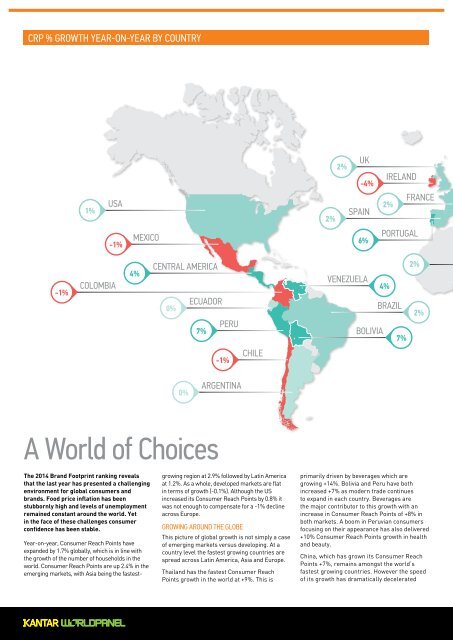brand-footprint-report_6
brand-footprint-report_6
brand-footprint-report_6
You also want an ePaper? Increase the reach of your titles
YUMPU automatically turns print PDFs into web optimized ePapers that Google loves.
CRP % GROWTH YEAR-ON-YEAR BY COUNTRY<br />
-1%<br />
USA<br />
1%<br />
-1%<br />
COLOMBIA<br />
MEXICO<br />
CENTRAL AMERICA<br />
4%<br />
ECUADOR<br />
0%<br />
PERU<br />
7%<br />
UK<br />
2%<br />
IRELAND<br />
-4%<br />
FRANCE<br />
2%<br />
SPAIN<br />
2%<br />
PORTUGAL<br />
6%<br />
2%<br />
VENEZUELA<br />
4%<br />
BRAZIL<br />
2%<br />
BOLIVIA<br />
7%<br />
GERMANY<br />
ITALY<br />
-8%<br />
SAUDI ARABIA<br />
0%<br />
GREECE<br />
-3%<br />
INDIA<br />
5%<br />
VIETNAM<br />
0%<br />
THAILAND<br />
9%<br />
SOUTH KOREA<br />
-3%<br />
CHINA<br />
7%<br />
TAIWAN<br />
5%<br />
PHILIPPINES<br />
MALAYSIA<br />
1%<br />
INDONESIA<br />
RUSSIA<br />
2%<br />
-1%<br />
1%<br />
-1%<br />
CHILE<br />
0%<br />
ARGENTINA<br />
KEY<br />
+3% 1 to 3% 0% up to -4% -4% onwards<br />
A World of Choices<br />
Indonesia, China and Vietnam growth based on urban population<br />
CRP growth based on top FMCG <strong>brand</strong>s in each country.<br />
The 2014 Brand Footprint ranking reveals<br />
that the last year has presented a challenging<br />
environment for global consumers and<br />
<strong>brand</strong>s. Food price inflation has been<br />
stubbornly high and levels of unemployment<br />
remained constant around the world. Yet<br />
in the face of these challenges consumer<br />
confidence has been stable.<br />
Year-on-year, Consumer Reach Points have<br />
expanded by 1.7% globally, which is in line with<br />
the growth of the number of households in the<br />
world. Consumer Reach Points are up 2.4% in the<br />
emerging markets, with Asia being the fastestgrowing<br />
region at 2.9% followed by Latin America<br />
at 1.2%. As a whole, developed markets are flat<br />
in terms of growth (-0.1%). Although the US<br />
increased its Consumer Reach Points by 0.8% it<br />
was not enough to compensate for a -1% decline<br />
across Europe.<br />
GROWING AROUND THE GLOBE<br />
This picture of global growth is not simply a case<br />
of emerging markets versus developing. At a<br />
country level the fastest growing countries are<br />
spread across Latin America, Asia and Europe.<br />
Thailand has the fastest Consumer Reach<br />
Points growth in the world at +9%. This is<br />
primarily driven by beverages which are<br />
growing +14%. Bolivia and Peru have both<br />
increased +7% as modern trade continues<br />
to expand in each country. Beverages are<br />
the major contributor to this growth with an<br />
increase in Consumer Reach Points of +8% in<br />
both markets. A boom in Peruvian consumers<br />
focusing on their appearance has also delivered<br />
+10% Consumer Reach Points growth in health<br />
and beauty.<br />
China, which has grown its Consumer Reach<br />
Points +7%, remains amongst the world’s<br />
fastest growing countries. However the speed<br />
of its growth has dramatically decelerated<br />
from last year as China’s economy slows<br />
leading consumers to become savvier and<br />
more price conscious.<br />
DECLINING WORLDWIDE<br />
The countries where Consumer Reach<br />
Points are declining most sharply are also<br />
spread across the world, although Eurozone<br />
members dominate. In Italy, where price<br />
inflation continues across all FMCG categories,<br />
Consumer Reach Points have declined by -8%.<br />
Ireland (-4%) and Greece (-3%) are fellow<br />
Eurozone countries tackling debt crises,<br />
sluggish economies and high unemployment.<br />
South Korea’s overall Consumer Reach Point<br />
decline of -3.2% has been caused by the -5%<br />
drop in home care, where a high number<br />
of shoppers have left the fabric softener<br />
segments, and a -1% fall in beverages. This<br />
overall decline reflects the ‘new normal’ for<br />
South Korean consumers caused by a postrecession<br />
economy in which the country’s GDP<br />
growth has stalled.<br />
LOCAL VS. GLOBAL BRANDS<br />
Local <strong>brand</strong>s are growing their Consumer<br />
Reach Points almost twice as fast (2%) as<br />
global <strong>brand</strong>s (1.2%), and local <strong>brand</strong>s continue<br />
to account for the majority of shoppers’<br />
purchase decisions (60%). This is the case<br />
across all regions – particularly Asia, where<br />
local <strong>brand</strong>s hold 69% of the total Consumer<br />
Reach Points achieved.<br />
Global <strong>brand</strong>s still perform more strongly<br />
in some countries: Bolivia, Central America,<br />
Peru, urban Vietnam, Malaysia, Saudi Arabia,<br />
Indonesia, India, France and the UK. In the US,<br />
75% of Consumer Reach Points are held by<br />
global <strong>brand</strong>s.<br />
6 | 7


